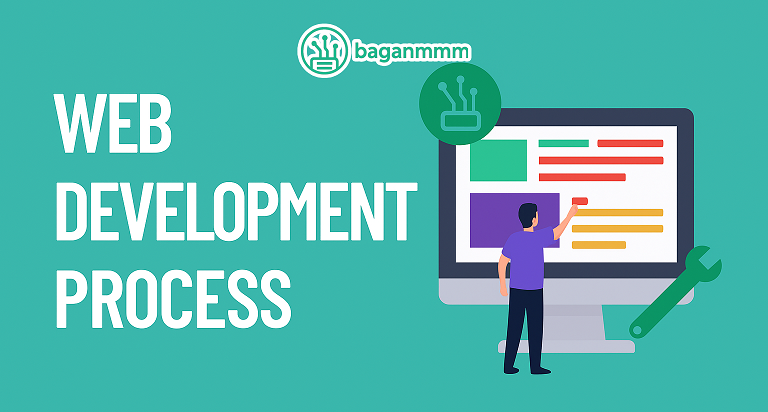Hi guys,
Since this blog is about the web development process, I’ll be sharing not just web technologies, but also the practical processes that developers actually go through. These are real, hands‑on experiences that you won’t usually find in training courses. If you are already a web developer, you’ve likely faced these situations. And if you’re still a learner, knowing these points will help you handle real‑world problems more effectively.

When building a website, the first thing you need to know is web technology. But simply knowing the technology is not enough. You also need to understand:
- The principles behind different types of websites
- User feedback and behavior
- Client requirements
- Data management
- Latest trends
- Roadmaps for development
These are the real challenges every web developer encounters, especially in project management.
Unlike coding tasks that can often be automated with AI, these are practical, human‑driven challenges that require judgment and experience. That’s why, in this blog, I’m sharing my own experiences and the roadmap I currently use to solve these issues. I hope this blog helps make these challenges easier for you to overcome.
1. Discovery & Requirements Gathering
Laying the Strategic Foundation for Web App Success
In 2025, the discovery phase is no longer a casual kickoff it’s a structured, strategic process that determines whether a client’s web app will succeed or stall. With remote collaboration, AI-assisted planning, and increasingly complex business models, gathering clear, actionable requirements is more critical than ever.
What Is Discovery?
Discovery is the process of understanding the client’s goals, users, workflows, and constraints. It’s where you ask the right questions, challenge assumptions, and define the why behind the web app — not just the what.
Types of Requirements You Must Capture
| Requirement Type | Description |
|---|---|
| Business Requirements | High-level goals aligned with the client’s strategy, such as increasing conversions or expanding market reach. |
| Functional Requirements | Specific features and capabilities the app must deliver, like user login, data filtering, or dashboard views. |
| Non-Functional Requirements | Performance, scalability, security, accessibility, and other quality attributes that define how the app behaves. |
| Technical Requirements | Preferred tech stack, hosting environment, third-party integrations, and API specifications. |
| Compliance Requirements | Legal, regulatory, or industry-specific standards the app must meet, such as GDPR, HIPAA, or PCI-DSS. |
Key Activities During Discovery
1. Stakeholder Interviews
Talk to decision-makers, end users, and technical leads. Use structured questions to uncover goals, frustrations, and expectations.
2. User Persona Mapping
Define who will use the app, what they need, and how they’ll interact with it. This guides UX decisions later.
3. Workflow Analysis
Map out current processes and identify inefficiencies. This helps translate real-world logic into digital flows.
4. Feature Prioritization
Use MoSCoW or RICE frameworks to rank features by impact and feasibility.
5. Risk Identification
Spot potential blockers early — unclear scope, legacy systems, or unrealistic timelines.
Tools That Elevate Discovery in 2025
Miro & FigJam: For collaborative whiteboarding and journey mapping
Notion & Confluence: For structured documentation and stakeholder alignment
ChatGPT & Copilot: For drafting requirement summaries and refining client language
RACI Matrix: To clarify roles and responsibilities across teams
AI-Powered Surveys: To gather feedback from distributed user groups
Common Pitfalls to Avoid
Jumping into design or development before defining scope
Assuming the client knows exactly what they need
Ignoring non-functional requirements like performance or accessibility
Failing to document decisions and assumptions
2. UX/UI Design & Prototyping
Turning Ideas into Interfaces That Feel Effortless
In 2025, UX/UI design is no longer just about aesthetics — it’s about crafting digital experiences that are intuitive, inclusive, and conversion-driven. For client web apps, this phase is where abstract goals become tangible screens. It’s where you validate ideas, reduce risk, and build trust before a single line of production code is written.
Key Goals of This Phase
Translate business logic into user flows
Design interfaces that feel natural across devices
Validate usability before development begins
Align stakeholders through visual storytelling
The Modern UX/UI Workflow
| Stage | Description |
|---|---|
| Research & Empathy | Understand user needs, pain points, and context through interviews, analytics, and competitor analysis. |
| Wireframing | Create low-fidelity layouts to map structure, navigation, and core interactions before visual design begins. |
| Visual Design | Apply branding, typography, and color systems to create high-fidelity mockups that reflect the final look and feel. |
| Prototyping | Build interactive simulations to test user flows, gather feedback, and validate usability before development. |
| Iteration | Refine designs based on usability testing, stakeholder input, and accessibility audits to ensure optimal experience. |
Top Prototyping Tools in 2025
According to UX Design Institute’s 2025 roundup, the most effective tools include:
Figma: All-in-one design, prototyping, and collaboration platform
ProtoPie: High-fidelity, no-code prototyping with realistic interactions
UXPin: Ideal for design systems and developer handoff
Uizard: AI-powered wireframing and rapid prototyping
Marvel: Quick design-to-test workflows for lean teams
These tools allow designers to simulate real user journeys, gather feedback, and iterate before development begins — saving time and reducing costly rework.
Why Prototyping Matters
Reduces ambiguity: Clients can see and interact with the product before it’s built
Improves usability: Early testing reveals friction points and accessibility gaps
Accelerates development: Developers get clear specs and behavior logic
Enhances collaboration: Stakeholders align visually, not just verbally
Best Practices for Client-Facing Prototypes
Use clickable flows to simulate real tasks
Label screens clearly for stakeholder walkthroughs
Include annotations for developer handoff
Test with real users or client staff before signoff
Keep versions organized and document feedback loops
3. Architecture Planning
Designing the Skeleton That Powers the Web App
In 2025, architecture planning is no longer just about choosing a tech stack it’s about designing a resilient, scalable, and secure foundation that aligns with the client’s business logic and future growth. With rising traffic demands, AI integrations, and multi-device access, your architecture must be modular, cloud-ready, and performance-optimized from day one.
What Is Web App Architecture?
Web application architecture defines how the frontend, backend, database, and infrastructure components interact. It’s the blueprint that governs data flow, user experience, and system behavior — ensuring that the app is fast, secure, and maintainable.
Key Components of Modern Web Architecture
| Component | Role in the System |
|---|---|
| Frontend (Client-Side) | Handles UI/UX, user interactions, and rendering logic using frameworks like React, Vue, or Angular. |
| Backend (Server-Side) | Processes requests, applies business logic, and communicates with databases and external services. |
| Database | Stores and retrieves structured or unstructured data using systems like PostgreSQL, MySQL, or MongoDB. |
| API Layer | Connects frontend and backend, often using RESTful or GraphQL endpoints to manage data exchange. |
| Authentication Service | Manages user sessions, token validation, and access control using OAuth2, JWT, or custom auth flows. |
| Cloud Infrastructure | Hosts and scales the app using platforms like AWS, Azure, or Firebase, supporting deployment and uptime. |
| Load Balancer | Distributes incoming traffic evenly across servers to prevent overload and ensure high availability. |
| CDN (Content Delivery Network) | Speeds up asset delivery and reduces latency by caching content closer to users via services like Cloudflare or Akamai. |
Architecture Models to Consider
1. Monolithic Architecture
- All components in one codebase
- Easier to build initially, harder to scale
- Suitable for MVPs or small apps
2. Microservices Architecture
- Each feature is a standalone service
- Scalable, fault-tolerant, ideal for large apps
- Requires orchestration tools (Docker, Kubernetes)
3. Serverless Architecture
- Functions triggered by events (AWS Lambda, Firebase Functions)
- Cost-efficient and scalable
- Best for lightweight, event-driven apps
4. Three-Tier Architecture
- Presentation → Logic → Data
- Classic model, still widely used for enterprise apps
Best Practices for Architecture Planning
Start with business logic: Architecture should reflect workflows, not just tech preferences
Plan for scalability: Use horizontal scaling, caching, and async processing
Secure by design: Apply encryption, token validation, and role-based access from the start
Document everything: Use diagrams, flowcharts, and API specs for clarity
Test early: Validate architecture with load testing and simulated traffic
4. Development & Integration
Building the Engine That Powers the Experience
In 2025, development is no longer just about writing code, it’s about orchestrating a modular, secure, and intelligent system that adapts to user needs and business goals. Integration, meanwhile, ensures that the app connects seamlessly with third-party services, internal tools, and cloud infrastructure.
This phase is where your architecture blueprint becomes a living product — and where collaboration between frontend, backend, and DevOps teams is critical.
Technologies Dominating in 2025
Frontend: React 19, Vue 4, Angular 16, Tailwind CSS, Material 3
Backend: Node.js 20, Django 5, Laravel 11, Go, Rust
APIs: REST, GraphQL, gRPC
Authentication: OAuth2, JWT, biometric login, WebAuthn
DevOps: Docker, Kubernetes, GitHub Actions, Vercel, Netlify
Cloud: AWS Amplify, Firebase, Azure Functions, Cloudflare Workers
Integration Trends in 2025
AI-Powered APIs: Apps now integrate with AI services for personalization, chatbots, and predictive analytics
Serverless Functions: Lightweight backend logic deployed via cloud functions for speed and cost-efficiency
Progressive Web Apps (PWAs): Offline access, push notifications, and mobile-first performance baked into web apps
Secure Data Pipelines: Encryption, token rotation, and zero-trust architecture are standard for sensitive integrations
Best Practices for Development & Integration
Modular Codebase: Use reusable components and services to reduce duplication
Secure by Default: Validate inputs, sanitize outputs, and enforce HTTPS
Test Continuously: Use unit, integration, and E2E tests with automated pipelines
Document Everything: Maintain API specs, code comments, and integration guides
Monitor & Optimize: Use tools like Sentry, Datadog, and Lighthouse to track performance and errors
5. Testing & Quality Assurance
Goal: Ensure stability, performance, and security.
- Perform unit, integration, and end-to-end testing
- Conduct cross-browser and device compatibility checks
- Run performance audits (Lighthouse, GTmetrix)
- Test for vulnerabilities (OWASP Top 10, penetration testing)
- Validate user experience with beta testers
6. Deployment & Launch
Goal: Go live with confidence and control.
- Set up production environment and DNS
- Configure SSL, caching, and CDN
- Monitor logs and analytics from day one
- Create rollback plans and backup systems
- Announce launch via client’s channels
7. Post-Launch Support & Optimization
Goal: Improve, scale, and adapt based on real usage.
- Monitor user behavior and feedback
- Fix bugs and release updates
- Optimize performance and SEO
- Add new features based on evolving needs
- Plan for long-term maintenance and scalability
Final Thought
In reality, the web development process can be defined as the structured organization of an entire digital economy. To build a high‑quality web application, these elements are essential. Only then can the final product meet professional standards.
Developers should not only be skilled in programming but also have a solid understanding of software skills. This broader knowledge helps them better understand the needs of both team members and clients.
This blog may feel a little complex for beginners. That’s because the topics discussed here reflect the daily challenges faced by senior developers and project managers. However, for beginners, learning these concepts early is an advantage because once you reach a senior level, you will inevitably face these same challenges. Understanding them now gives you a head start.
Alice is the visionary behind Baganmmm Tech, a platform he founded with a passion for demystifying the complex world of technology. As the Lead Technologist, he's often found in his home lab – a cozy, wire-filled sanctuary where ideas are born and code is meticulously crafted. His infectious enthusiasm and knack for explaining intricate concepts make him the go-to expert for everything from web development to emerging tech trends.
